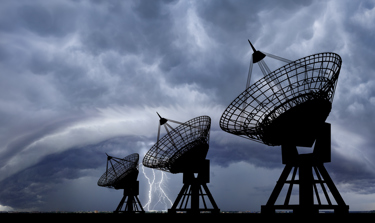Radar Antennas: Applications, Types, And Market Dynamics

By John Oncea, Editor

Radar antennas play a vital role in various applications such as weather forecasting, traffic control, and military operations. Current market growth is being driven by increasing demand across industries, advancements in technology leading to more efficient and eco-friendly options, and government regulations. Let’s take a closer look at these unsung heroes of modern radar systems.
Radar antenna is from Ottumwa, IA, and dreamed of joining the army after high school. He has extra-sensory perception and an uncanny ability to anticipate his commander’s needs. Although warm, friendly, and innocent, Radar also can be sneaky. His go-to drink is grape Nehi and he’s not what you’d call a ladies’ man.
Hold on. Being told that’s M*A*S*H character Radar O’Riley. Let’s try this again.
Let’s Talk Real Radar Antennas
Radar antennas are one part of a radar system that, according to JEM Engineering, has “a wide range of applications, including weather forecasting, traffic control, navigation, automotive systems, and aviation. In military and defense operations, a radar system can be used to detect, track, and identify objects in the air, on land, and at sea.”
The antenna’s role in a radar system is to emit “extremely short bursts of radio waves, called pulses,” writes The National Weather Service (NWS). “Each pulse lasts about 0.00000157 seconds (1.57x10 -6), with a 0.00099843-second (998.43x10 -6) ‘listening period’ in between. The transmitted radio waves move through the atmosphere at about the speed of light.”
By measuring the time it takes for the radio wave signal to return, the radar system can determine the location, speed, and other characteristics of objects within its field of view. Direction also can be determined by analyzing the frequency and phase of the signal.
The market for radar antennas is expected to continue growing steadily in the coming years, notes Market Info Research. One of the main drivers of growth is the increasing demand from various industries such as healthcare, automotive, and consumer electronics. Furthermore, technological advancements, including the development of more efficient and cost-effective radar antennas, are also expected to fuel market expansion.
In addition, the growing concern for the environment has led to the creation of more sustainable and eco-friendly radar antenna options, which is expected to further boost market growth. Government regulations and policies are also expected to play a critical role in shaping the market, as they can impact the production, distribution, and use of radar antennas.
Everyone Has A Type
There are several different types of radar antenna, each of which has a distinct design and functionality, with the parabolic antenna being “arguably” the most popular type. Other common types of antennas include horn antennas and phased array antennas.
A parabolic antenna, according to Electricity-Magnetism (EM), is “commonly known as a ‘dish’ antenna (and) plays a significant role in modern communication systems. It is a high-gain antenna that is designed to receive and transmit signals in a specific direction. Unlike other antenna types, parabolic antennas are unique due to their structure and their ability to focus radio waves in a beam.
Parabolic antennas are widely used in satellite communication due to their high gain and directional nature. They are particularly suited to transmit signals to and receive signals from satellites. These antennas are also extensively used in radio astronomy to detect and study weak radio waves from space. As a result, they provide valuable information about celestial bodies and phenomena.
“Parabolic antennas have proved to be a valuable asset in telecommunication systems, including microwave relay links that carry telephone and television signals over considerable distances,” writes EM. “Their high gain and focused transmission characteristics ensure the delivery of high-quality signals across these distances.”
Horn antennas are flared waveguide microwave antennas that offer high directivity and gain. They are widely used in radar, communication, and radio astronomy applications due to their low loss, wide bandwidth, and high gain.
“They’re employed in radar, satellite, wireless comms, and research and prospects look promising as tech advancements may boost their efficiency and versatility,” EM writes.
Finally, phased array antennas, an antenna that uses “multiple elements to steer radio waves, enabling rapid scanning and multi-beam communication in various industries,” according to EM. They are better than traditional antennas because they can steer beams quickly, operate multiple beams simultaneously, are smaller in size, and have increased reliability. However, they face some challenges such as high cost, power consumption, and integration issues. Future developments aim to address these challenges by using metamaterials, AI, and flexible arrays.
Not Resting On Its Laurels
Radar antennas have not evolved as dramatically or rapidly as other technologies, but there has been an evolution driven by changes in communication standards and evolving consumer needs.
JEM Engineering writes that the transition from analog to digital, especially within the past decade, has led to the widespread adoption of mobile devices which in turn has influenced the design and functionality of antennas, with many now optimized for digital signals.
3G, 4G/LTE, and 5G have “led to the development of antennas capable of supporting higher data rates and increased bandwidth,” writes JEM. “Antennas have become more complex to handle the diverse frequency ranges and modulation schemes associated with these standards.” Advancements in miniaturization have led to the development of smaller antennas that can be integrated into more devices including smartphones.
Antenna types have changed as well, JEM notes. “Different applications and communication needs have given rise to various types of antennas, including patch antennas, dipole antennas, helical antennas, and phased array antennas. The industry has diversified to cater to specific use cases and environments.”
JEM notes an additional seven ways antennas have changed, concluding, “The antenna industry has evolved significantly over the past several decades, driven by technological advancements, changes in communication standards, and the increasing demand for wireless connectivity across various applications. The ongoing development of 5G networks and the continued expansion of IoT are expected to further shape the future of the antenna industry.
